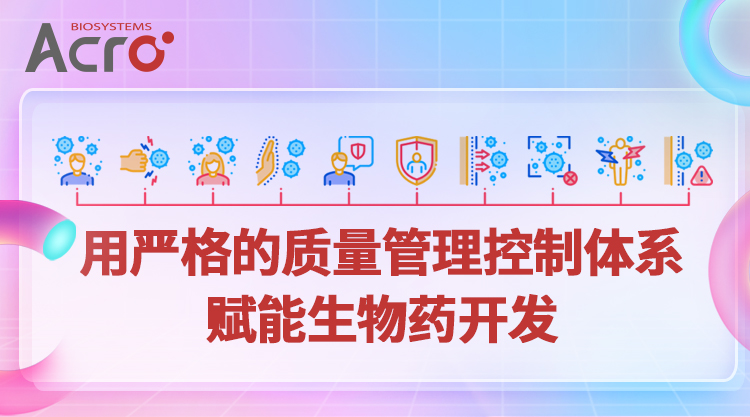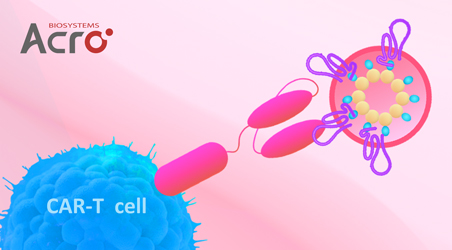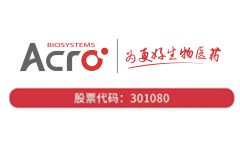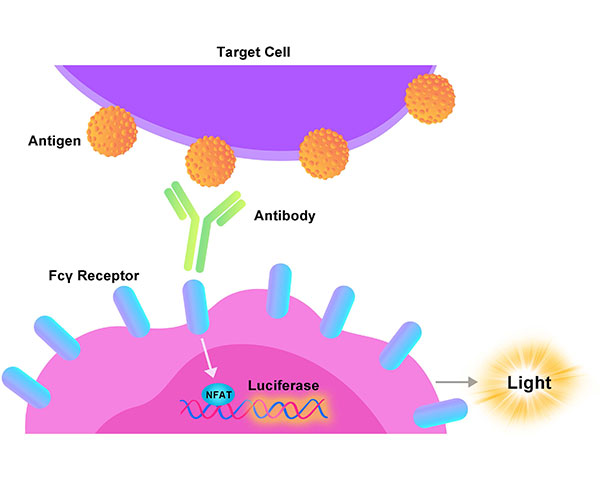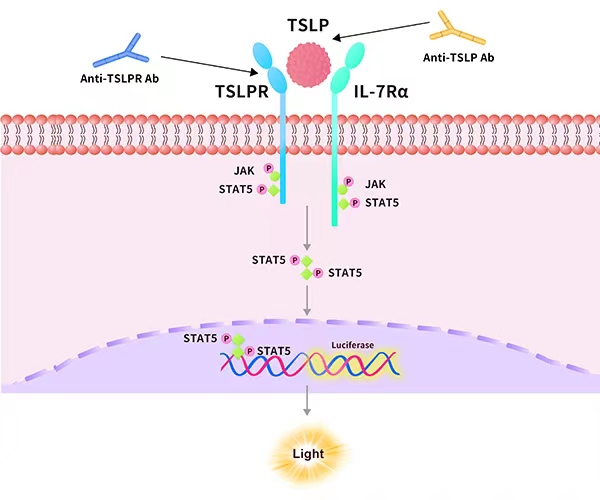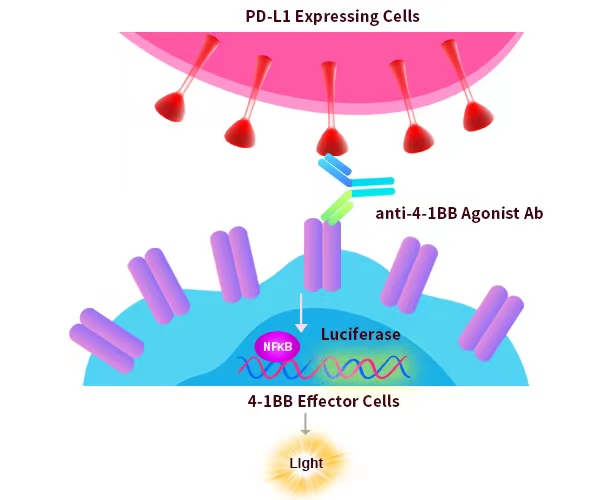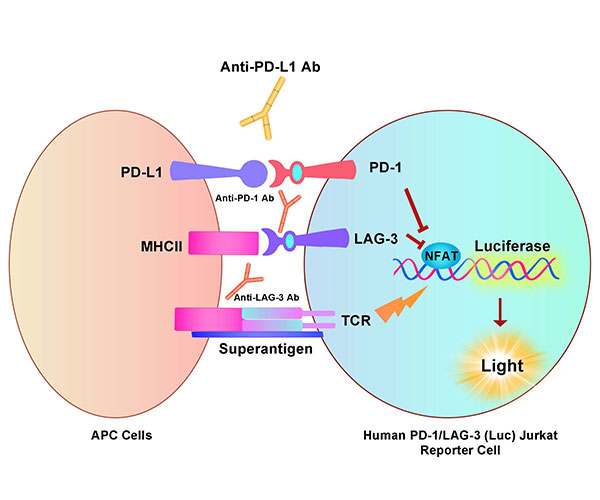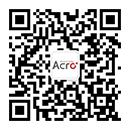| 5-HT1A |
CHEK-ATF131 |
Human 5-HT1A (Luc) HEK293 Reporter Cell |
| Activin RII |
CHEK-ATF164 |
Human Activin RIl (Luc) HEK293 Reporter Cell |
| DR3 |
SCJUR-STF178 |
Human DR3 (TL1A receptor) (Luc) Jurkat Reporter Cell Development Service |
| EGF R |
CHEK-ATF049 |
EGFR (Luc) HEK293 Reporter Cell |
| FGF-21 |
CHEK-ATF163 |
Human FGF-21 (Luc) HEK293 Reporter Cell |
| GCGR |
CHEK-ATF103 |
Human GCGR (Luc) HEK293 Reporter Cell |
| GIPR |
CHEK-ATF104 |
Human GIPR (Luc) HEK293 Reporter Cell |
| GLP-1R |
CHEK-ATF096 |
Human GLP-1R (Luc) HEK293 Reporter Cell |
| GLP-2R |
CHEK-ATF128 |
Human GLP-2R (Luc) HEK293 Reporter Cell |
| HGF R |
CHEK-ATF144 |
Human c-MET (Luc) HEK293 Reporter Cell |
| IGF-I R |
CHEK-ATF107 |
Human IGF-1 R (Luc) HEK293 Reporter Cell |
| IL-10 R alpha/IL-10 R beta |
CHEK-ATF095 |
Human IL-10 R alpha/IL-10 R beta (Luc) HEK293 Reporter Cell |
| IL-11 R alpha |
CHEK-ATF052 |
Human IL-11 R alpha (Luc) HEK293 Reporter Cell |
| IL-17 RA & IL-17 RC |
CHEK-ATF133 |
Human IL-17 RA/IL-17 RC (Luc) HEK293 Reporter Cell |
| IL-2 R beta & IL-2 R gamma |
CHEK-ATF136 |
Human IL-2 R beta/IL-2 R gamma (Luc) HEK293 Reporter Cell |
| IL-21 R |
CHEK-ATF051 |
Human IL-21 R/CD132 (Luc) HEK293 Reporter Cell |
| IL-31 RA / OSMR |
CHEK-ATF094 |
Human IL-31 RA/OSMR (Luc) HEK293 Reporter Cell |
| IL-4 R alpha/IL-13 R alpha 1 |
CHEK-ATF075 |
Human IL-4 R alpha/IL-13 R alpha 1 (Luc) HEK293 Reporter Cell |
| IL-5 R alpha/CD131 |
CHEK-ATF074 |
Human IL-5 R alpha/CD131 (Luc) HEK293 Reporter Cell |
| IL-7 R alpha |
CHEK-ATF099 |
Human IL-7 R alpha/CD132 (Luc) HEK293 Reporter Cell |
| IL-7 R alpha & TSLP R |
CHEK-ATF045 |
Human TSLP R (Luc) HEK293 Reporter Cell |
| ISRE |
CHEK-ATF134 |
ISRE (Luc) HEK293 Reporter Cell |
| NF-κB |
CHEK-ATF048 |
NF-κB (Luc) HEK293 Reporter Cell |
| NF-κB |
SCJUR-STF113 |
NF-kB (Luc) Jurkat Reporter Cell Development Service |
| NFAT |
CHEK-ATF050 |
NFAT (Luc) HEK293 Reporter Cell |
| NFAT |
SCJUR-STF046 |
NFAT (Luc) Jurkat Reporter Cell Development Service |
| NKp46 |
SCJUR-STF130 |
Human NKp46 (Luc) Jurkat Reporter Cell Development Service |
| OX40 |
CHEK-ATF135 |
Human OX40 (Luc) HEK293 Reporter Cell |
| RANK |
CHEK-ATF129 |
Human RANK (Luc) HEK293 Reporter Cell |
| STAT3 |
CHEK-ATF047 |
STAT3 (Luc) HEK293 Reporter Cell |
| TCF/LEF |
CHEK-ATF114 |
TCF/LEF (Luc) HEK293 Reporter Cell |
| TGF-beta 1 |
CHEK-ATF145 |
Human TGF-beta R (Luc) HEK293 Reporter Cell |
| THRA |
CHEK-ATF180 |
Human THRA (Luc) HEK293 Reporter Cell |
| THRB |
CHEK-ATF181 |
Human THRB (Luc) HEK293 Reporter Cell |
| TrkA |
CHEK-ATF093 |
Human TrkA (Luc) HEK293 Reporter Cell |
| VEGF R2 |
CHEK-ATF044 |
VEGFR2 (Luc) HEK293 Reporter Cell |
| 4-1BB |
CHEK-ATP038 |
HEK293/Human 4-1BB / TNFRSF9 Stable Cell Line |
| 4-1BB Ligand |
CHEK-ATP039 |
HEK293/Human 4-1BB Ligand / TNFSF9 Stable Cell Line |
| Alpha-synuclein |
CHEK-ATP085 |
HEK293/Human Alpha-synuclein (GFP) Stable Cell Line |
| APP |
CHEK-ATP081 |
HEK293/Human APP (GFP) Stable Cell Line |
| ASGR1 |
CHEK-ATP080 |
HEK293/Human ASGR1 Stable Cell Line |
| ASGR1&ASGR2 |
CHEK-ATP172 |
HEK293/Human ASGR1&ASGR2 Stable Cell Line |
| B7-H3 |
CHEK-ATP118 |
HEK293/Human B7-H3 Stable Cell Line |
| B7-H3 (4Ig) |
SCCHO-ATP169 |
CHO/Human B7-H3 (4Ig) Stable Cell Line Development Service |
| B7-H4 |
CHEK-ATP126 |
HEK293/Human B7-H4 Stable Cell Line |
| Cadherin-17 |
CHEK-ATP173 |
HEK293/Human Cadherin-17 Stable Cell Line |
| Cadherin-6 |
CHEK-ATP127 |
HEK293/Human Cadherin-6 Stable Cell Line |
| CCR5 |
CHEK-ATP043 |
HEK293/Human CCR5 Stable Cell Line |
| CCR8 |
CHEK-ATP140 |
HEK293/Human CCR8 Stable Cell Line |
| CD19 |
CHEK-ATS056 |
HEK293/Human Anti-CD19 Stable Cell Line |
| CD20 |
CHEK-ATP034 |
HEK293/Human CD20 Stable Cell Line |
| CD79A & CD79B |
SCCHO-ATP170 |
CHO/Human CD79A&CD79B Stable Cell Line Development Service |
| CD79B |
SCCHO-ATP171 |
CHO/Human CD79B Stable Cell Line Development Service |
| CEACAM-5 |
CHEK-ATP083 |
HEK293/Human CEACAM5 Stable Cell Line |
| CEACAM-5 |
SCCHO-ATP081 |
CHO/Human CEACAM5 Stable Cell Line Development Service |
| Claudin-1 |
CHEK-ATP124 |
HEK293/Human Claudin-1 Stable Cell Line |
| Claudin-18.2 |
CHEK-ATP033 |
HEK293/Human Claudin-18.2 Stable Cell Line |
| Claudin-6 |
CHEK-ATP138 |
HEK293/Human Claudin-6 Stable Cell Line |
| Claudin-9 |
CHEK-ATP139 |
HEK293/Human Claudin-9 Stable Cell Line |
| DLL3 |
CHEK-ATP090 |
HEK293/Human DLL3 Stable Cell Line |
| DLL3 |
SCCHO-ATP111 |
CHO/Human DLL3 Stable Cell Line Development Service |
| EGF R |
CHEK-ATP148 |
HEK293/Human EGF R Stable Cell Line |
| ENPP3 |
CHEK-ATP122 |
HEK293/Human ENPP3 Stable Cell Line |
| EpCAM |
CHEK-ATP175 |
HEK293/Human EpCAM Stable Cell Line |
| ErbB3 |
CHEK-ATP149 |
HEK293/Human ErbB3 Stable Cell Line |
| FAP |
CHEK-ATP184 |
HEK293/Human FAP Stable Cell Line |
| FcRn (FCGRT & B2M) |
CHEK-ATP079 |
HEK293/Human FcRn (FCGRT & B2M) Stable Cell Line |
| FcRn (FCGRT & B2M) |
CHEK-ATP132 |
HEK293/FcRn (FCGRT & B2M), GFP Tag Stable Cell Line |
| FOLR1 |
CHEK-ATP091 |
HEK293/Human FOLR1 Stable Cell Line |
| GLP1R |
CHEK-ATP160 |
HEK293/Human GLP-1R Stable Cell Line (High Expression) |
| GLP1R |
CHEK-ATP161 |
HEK293/Human GLP-1R Stable Cell Line (Medium Expression) |
| GLP1R |
CHEK-ATP162 |
HEK293/Human GLP-1R Stable Cell Line (Low Expression) |
| Glypican 3 |
SCCHO-ATP112 |
CHO/Human Glypican-3 (GPC3) Stable Cell Line Development Service |
| Glypican-3 |
CHEK-ATP092 |
HEK293/Human Glypican-3 (GPC3) Stable Cell Line |
| Glypican-3 |
CHEK-ATP177 |
HEK293/Cynomolgus Glypican-3 (GPC3) Stable Cell Line |
| Glypican-3 |
SCCHO-ATP179 |
CHO/Cynomolgus Glypican-3 (GPC3) Stable Cell Line Development Service |
| GPR75 |
CHEK-ATP174 |
HEK293/Human GPR75 Stable Cell Line |
| GPRC5D |
CCHO-STP078 |
CHO/Human GPRC5D Stable Cell Line |
| GPRC5D |
CHEK-STP042 |
HEK293/Human GPRC5D Stable Cell Line |
| GUCY2C |
CHEK-ATP182 |
HEK293/Human GUCY2C Stable Cell Line |
| Her2 |
CHEK-ATP150 |
HEK293/Human ErbB2 Stable Cell Line |
| HGF R |
CHEK-ATP146 |
HEK293/Human c-MET Stable Cell Line |
| HGF R |
SCCHO-ATP141 |
CHO/Human c-MET Stable Cell Line Development Service |
| HVEM |
CHEK-ATP147 |
HEK293/Human HVEM Stable Cell Line |
| IGF-I R |
CNIH-ATP102 |
NIH-3T3/Human IGF-1 R Stable Cell Line Development Service |
| Integrin alpha V beta 6 |
CHEK-ATP125 |
HEK293/Human Integrin alpha V beta 6 Stable Cell Line |
| LDL R |
CHEK-ATP158 |
HEK293/Human LDL R Stable Cell Line |
| LILRB3 |
CHEK-ATP159 |
HEK293/Human LILRB3 Stable Cell Line |
| LILRB4 |
CHEK-ATP088 |
HEK293/Human LILRB4 Stable Cell Line |
| LILRB4 |
SCCHO-ATP087 |
CHO/Human LILRB4 Stable Cell Line Development Service |
| LRRC15 |
CHEK-ATP123 |
HEK293/Human LRRC15 Stable Cell Line |
| LY6G6D |
CHEK-ATP137 |
HEK293/Human LY6G6D Stable Cell Line |
| Mesothelin |
CHEK-ATP119 |
HEK293/Human Mesothelin Stable Cell Line |
| Mesothelin |
SCCHO-ATP120 |
CHO/Human Mesothelin Stable Cell Line Development Service |
| NAPI-IIb |
CHEK-ATP116 |
HEK293/Human NAPI-IIb Stable Cell Line |
| Nectin-4 |
CHEK-ATP035 |
HEK293/Human Nectin-4 Stable Cell Line |
| NGFR |
CHEK-ATP157 |
HEK293/Human NGFR Stable Cell Line |
| NKp46 |
CHEK-ATP153 |
HEK293/Human NKp46 Stable Cell Line |
| NY-ESO-1 |
CHEK-STP114 |
NY-ESO-1 specific TCR-HEK293 cell line |
| OX40 |
CHEK-ATP053 |
HEK293/Human OX40 / TNFRSF4 / CD134 Stable Cell Line |
| OX40 Ligand |
CHEK-ATP054 |
HEK293/Human OX40 Ligand / TNFSF4 Stable Cell Line |
| PD-L1 |
CHEK-ATP002 |
HEK293/Human PD-L1, GFP Tag Stable Cell Line |
| PSMA |
CHEK-ATP185 |
HEK293/Human PSMA Stable Cell Line |
| PTK7 |
CHEK-ATP186 |
HEK293/Human PTK7 Stable Cell Line |
| RAGE |
CHEK-ATP156 |
HEK293/Human RAGE Stable Cell Line |
| ROR1 |
CHEK-ATP084 |
HEK293/Human ROR1 Stable Cell Line |
| ROR1 |
SCCHO-ATP083 |
CHO/Human ROR1 Stable Cell Line Development Service |
| SEZ6 |
CHEK-ATP183 |
HEK293/Human SEZ6 Stable Cell Line |
| Sortilin |
CHEK-ATP155 |
HEK293/Human SORT1 Stable Cell Line |
| STEAP1 |
CHEK-ATP154 |
HEK293/Human STEAP1 Stable Cell Line |
| STEAP1 |
SCCHO-ATP121 |
CHO/Human STEAP1 Stable Cell Line Development Service |
| Tau |
CHEK-ATP087 |
HEK293/Human Tau-K18 (GFP) Stable Cell Line |
| TL1A |
CHEK-ATP142 |
HEK293/Human TL1A Stable Cell Line |
| TMPRSS2 |
CHEK-ATP101 |
HEK293/Human TMPRSS2-HA-P2A-mGFP Stable Cell Line |
| TPBG |
CHEK-ATP176 |
HEK293/Human TPBG Stable Cell Line |
| Transferrin |
CHEK-ATP115 |
HEK293/Human Transferrin Stable Cell Line |
| Transferrin R |
CHEK-ATP089 |
HEK293/Human Transferrin R Stable Cell Line |
| TrkB |
CHEK-ATP082 |
HEK293/Human TrkB Stable Cell Line |
| TROP-2 |
CHEK-ATP036 |
HEK293/Human TROP-2 Stable Cell Line |
| TSHR |
CHEK-ATP086 |
HEK293/Human TSHR Stable Cell Line |
| TSHR |
SCCHO-ATP085 |
CHO/Human TSHR Stable Cell Line Development Service |
| uPAR |
CHEK-ATP151 |
HEK293/Human uPAR Stable Cell Line |
| uPAR |
SCCHO-ATP152 |
CHO/Human uPAR Stable Cell Line Development Service |























 Star Ribbon预染蛋白Marker蛋白质标记物是生物研究和药物开发的重要组成部分。无论是用于蛋白质电泳还是western blot,我们的预染色蛋白质标记物帮助您快速确定目标蛋白质的分子量或评估转移效率。Fc受体蛋白治疗性抗体的功效取决于Fab片段及其对目标抗原的结合活性,还取决于Fc片段及其与关键Fc受体的相互作用。因此,在抗体工程中候选物必须针对一系列受体进行测试。探索我们的重组Fc受体蛋白质的全面收藏!
Star Ribbon预染蛋白Marker蛋白质标记物是生物研究和药物开发的重要组成部分。无论是用于蛋白质电泳还是western blot,我们的预染色蛋白质标记物帮助您快速确定目标蛋白质的分子量或评估转移效率。Fc受体蛋白治疗性抗体的功效取决于Fab片段及其对目标抗原的结合活性,还取决于Fc片段及其与关键Fc受体的相互作用。因此,在抗体工程中候选物必须针对一系列受体进行测试。探索我们的重组Fc受体蛋白质的全面收藏!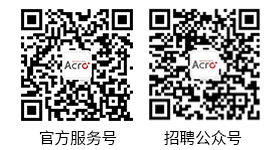


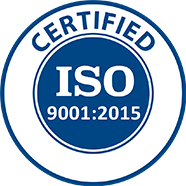
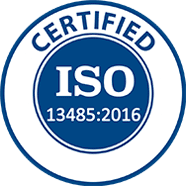
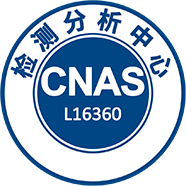

























 膜杰作
膜杰作 Star Staining
Star Staining
